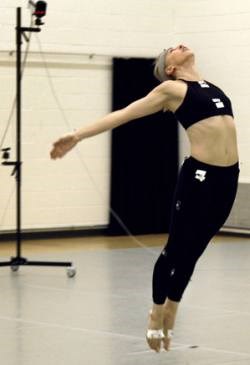NEWS RELEASE
INDIANA UNIVERSITY
**************************
"I think audiences are ready for this" - motion capture and modern dance
Ben Munisteri of the New York-based Ben Munisteri Dance Projects is in the midst of creating a potentially groundbreaking modern dance piece.
His organic, progressive vision for Terra Nova requires an executive director, a computer animator, and the expertise and equipment at Indiana University's new ergonomics laboratory.
"I think audiences are ready for this," Munisteri said of the marriage of modern dance and motion-capture technology, the same technology used to animate many video games and to create movie characters such as Star Wars androids and Gollum in the Lord of the Rings.
(Photo, courtesy of Indiana University, shows Lisa Wheeler, associate artistic director for Ben Munisteri Dance Projects, dancing wearing sensors that reflect infrared light.)
Munisteri is spending three weeks this month as an artist in residence with IU's contemporary dance program, which is housed in the department of kinesiology.
Each afternoon he and his six dancers work on the new creation, which will premiere in April on the West Coast.
In the evenings, Munisteri works with IU's modern dance majors, helping them learn his Muse of Fire which the IU Dance Theatre will present in January.
"The students are just so enthusiastic. You couldn't ask for a more dedicated, focused group," Munisteri said. "They're hungry for this."
Elizabeth Shea, coordinator of the IU contemporary dance program, couldn't be more enthusiastic about the melding of art, science and technology - and the fact that it's happening at the IU School of Health, Physical Education and Recreation, where students and faculty with similar interests can get an up-close look at this creative process.
"This is up and coming stuff," Shea said. "Artists and scientists have had these ideas, but we're only now getting the technology to support the interaction. Being able to watch the process, creating a framework for it to happen, is exciting. It's exciting for IU to provide this for a professional modern dance company."
Munisteri is tapping the resources and expertise of three universities: New York University, IU's School of HPER and its new Indiana Ergonomics Laboratory, and the University of California in Santa Cruz.
His computer animator, Peter Birdsall, comes from NYU.
Munisteri has taken the unusual step of enlisting the help of an executive director, Ted Warburton, a professor of dance and digital new media at the UCSC.
The Indiana Ergonomics Laboratory provided critical motion-capture technology and expertise.
The new laboratory is equipped with a sophisticated 3-D video motion analysis system, which consists of eight high-speed, digital cameras connected to a force plate, which records ground reaction forces, as well as an electromyography (EMG) system that allows analysis of muscle activity during the performance of a motor skill.
For Terra Nova, the eight cameras recorded the performance of the dancers by emitting an infrared light that reflected off of sensors placed on the dancers.
The cameras both emitted and collected the light and its reflection, and then the digital data were synthesized using motion-capture software.
What will emerge is a 3-D rendering of a moving human form, which can be viewed from a variety of angles - unlike a dancer on a stage.
"You can just swoop around the dancer - there's no angle from which you can't look at the dancer," Munisteri said. "We know that when you watch a dance performance you have one perspective, and that's where you're sitting."
While motion-capture technology has been used in modern dance for just a few years, it has been a standard tool for some of Shea's colleagues in the Department of Kinesiology, where it has been used for more than 30 years to analyze athletic technique and motion.
Faculty with the Indiana Ergonomics Laboratory use the 3-D video motion-analysis system to conduct research on workplace skills in order to determine the causes of musculoskeletal injuries and accidents.
Munisteri, with the help of the computer animator, set designers and others on his team, plans to transform a plain stage into an earthy, dynamic environment, projecting lava, ash, plant life, water, steam and other organic images pulsing and moving with the abstract images of his dancers.
While the on-stage dancers will change over time, the projected images will always be of the motion-capture work conducted at IU, with the images appearing wherever and whenever Terra Nova is performed, whether in New York City theatres or abroad.
"This will have untold significance in terms of visibility for Indiana University and the perception by both artists and scholars that Indiana is a place where creative digital arts are both thriving and supported," Shea said.
Terra Nova will premiere on April 13-14 at the UCSC Arts and Lectures Series.
After that, it will be performed in New York and elsewhere during the dance company's 2006-2007 season.
Shea said she is looking into the possibility of the company bringing the performance to Bloomington.
The IU Dance Theatre will present Munisteri's Muse of Fire on Jan. 11-12 at 7:30 p.m. at the Ruth N. Halls Theatre.
Munisteri's IU residency is funded with a grant from IU's New Frontiers in the Arts and Humanities Program.
***********************
More SooToday.com entertainment headlines
Join SooToday+
- Messages
- Post a Listing
- Your Listings
- Your Profile
- Your Subscriptions
- Your Likes
- Your Business
- Support Local News
- Payment History
SooToday+ members
Already a +member?
Not a +member?
Sign up for a SooToday+ account for instant access to upcoming contests, local offers, auctions and so much more.
